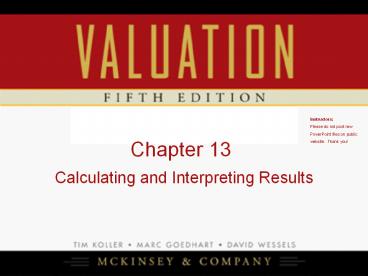Calculating and Interpreting Results - PowerPoint PPT Presentation
Title:
Calculating and Interpreting Results
Description:
Chapter 13. Calculating and Interpreting Results. Instructors: Please do not post raw PowerPoint files on public website. Thank you! – PowerPoint PPT presentation
Number of Views:41
Avg rating:3.0/5.0
Title: Calculating and Interpreting Results
1
Chapter 13
Instructors Please do not post raw PowerPoint
files on public website. Thank you!
- Calculating and Interpreting Results
2
Session Overview
- Is the Model Technically Robust? Ensure that all
checks and balances in your model are in place,
such as whether the balance sheet balances. - Is the Model Economically Consistent? The next
step is to check that your results reflect
appropriate value driver economics. For example,
does invested-capital turnover increase over time
for sound economic reasons? - Perform a Sensitivity Analysis. With a robust
model in hand, test how the companys value
responds to changes in key inputs. Start with a
single input analysis, and then change multiple
inputs simultaneously. - Use Scenario Analysis to Address Uncertainty.
Since the future is never truly knowable,
consider making financial projections under
multiple scenarios. The scenarios should reflect
different assumptions regarding future
macroeconomic, industry, or business
developments, as well as the corresponding
strategic responses by industry players.
3
Is the Model Technically Robust?
- In the unadjusted financial statements, the
balance sheet should balance every year, both
historically and in forecast years. Check that
net income flows correctly into dividends paid
and retained earnings. - In the rearranged financial statements, check
that the sum of invested capital plus
nonoperating assets equals the cumulative sources
of financing. - Is net operating profit less adjusted taxes
(NOPLAT) identical when calculated top-down from
sales and bottom-up from net income? Does net
income correctly link to dividends and retained
earnings in adjusted equity? Does the change in
excess cash and debt line up with the cash flow
statement?
4
Is the Model Technically Robust?
- For example
- In the rearranged financial statements, check
that the sum of invested capital plus
nonoperating assets equals the cumulative sources
of financing.
5
Is the Model Economically Consistent?
- Are the patterns intended? For example, does
invested-capital turnover increase over time for
sound economic reasons (economies of scale) or
simply because you modeled future capital
expenditures as a fixed percentage of revenues? - Are the patterns reasonable? Avoid large step
changes in key assumptions from one year to the
next, because these will distort key ratios and
could lead to false interpretations. For example,
a large single-year improvement in capital
efficiency could make capital expenditures in
that year negative, leading to an unrealistically
high cash flow. - Are the patterns consistent with industry
dynamics? In certain cases, reasonable changes in
key inputs can lead to unintended consequences. - Is a steady state reached for the companys
economics by the end of the explicit forecasting
period (that is, when you apply a
continuing-value formula)? A company achieves a
steady state only when its free cash flows are
growing at a constant rate.
6
Is the Model Economically Consistent?
- For example
- Are the patterns consistent with industry
dynamics? In certain cases, reasonable changes in
key inputs can lead to unintended consequences.
ROIC Impact of Small Changes Sample Price and
Cost Trends
Minor changes in price growth and cost reduction
can lead to unrealistic improvements in ROIC
over long periods.
7
Are the Results Plausible?
- Perform a sound multiples analysis. Calculate the
implied forward-looking valuation multiples of
the operating value over, for example, EBITA, and
compare these with equivalently defined multiples
of traded peer-group companies.
Specialty Retail Trading Multiples, December 2009
8
Perform a Sensitivity Analysis
- With a robust model in hand, test how the
companys value responds to changes in key
inputs. - Senior management can use sensitivity analysis to
prioritize the actions most likely to affect
value materially. - From the investors perspective, sensitivity
analysis can focus on which inputs to investigate
further and monitor more closely. - Assessing the Impact of Individual Drivers. Start
by testing each input one at a time to see which
has the largest impact on the companys
valuation. - Analyzing Trade-Offs. Strategic choices typically
involve trade-offs between inputs into your
valuation model. For instance, raising prices
leads to fewer purchases, lowering inventory
results in more missed sales, and entering new
markets often affects both growth and margin.
9
Assessing the Impact of Individual Drivers
- Start by testing each input one at a time to see
which has the largest impact on the companys
valuation. - Among the alternatives presented, a permanent
one-percentage-point reduction in selling
expenses has the greatest effect on the companys
valuation.
Sample Sensitivity Analysis
10
Analyzing Trade-Offs
- Although an input-by-input sensitivity analysis
will increase your knowledge about which inputs
drive the valuation, its use is limited. - First, inputs rarely change in isolation. For
instance, an increase in selling expenses is
likely to accompany an increase in revenue
growth. - Second, when two inputs are changed
simultaneously, interactions can cause the
combined effect to differ from the sum of the
individual effects.
Valuation Isocurves by Growth and Margin
11
Use Scenario Analysis
- Build a set of scenarios that reflect different
assumptions regarding future macroeconomic,
industry, or business developments, as well as
the corresponding strategic responses by industry
players. - Each value driver should be consistent with the
overall scenario.
Key Value Drivers by Scenario
12
Use Scenario Analysis
- Assess how likely it is that the key assumptions
underlying each scenario will change, and assign
to each scenario a probability of occurrence.
Example of a Scenario Approach to DCF Valuation































